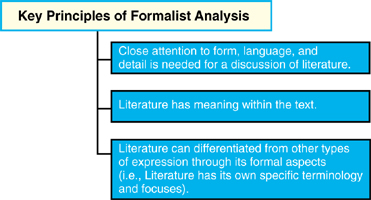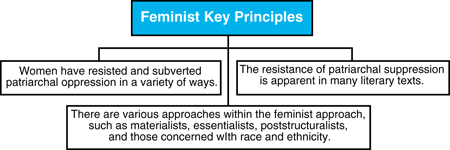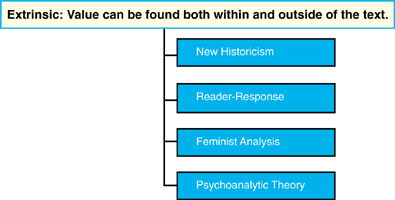 username@email.com
username@email.com
In this section the following major critical approaches will be covered: formalism, new historicism, feminism, psychoanalytic theory, and reader-response theory.
To watch a video on classroom demonstration.
Before tackling each of these approaches individually, note that the above schools of thought can be lumped into two groups: intrinsic and extrinsic.
1) Intrinsic: This group includes the formalists and all of their subgroups.
2) Extrinsic: Everyone else!
We’ll begin with the intrinsic group. This approach considers only the intrinsic value of a text. This approach does not consider any outside influences, such as historical, social, political, or even personal events or trends. A text should be valued, or not valued as the case may be, based on what is written.
There are three main subgroups within the formalist approach:
1) Russian Formalism
2) New Criticism
3) Neo-Aristotelianism
It is not necessary to know specifics about the three subgroups. Simply know that of the three, New Criticism is the approach that is used most widely.

Which aspect of the novel To Kill a Mockingbird would a formalist critic use in his or her analysis?
Now that we have covered the intrinsic portion of the critical approaches, we can move on to everything else.
Great question! It means that the analysis of a literary text is not limited only to what is in the text but can and does include outside influences. This is not to say that it only considers outside influences; instead it combines both the value of the text itself and the value of its background, author, audience, or history. Notice the use of the word or. This is because the following approaches focus on one or two outside influences.
For example, the new historicist critics focus on the historical and social implications of a text. Many literary works have been born out of political and social unrest. This approach was a direct reaction against the formalist and new criticism approaches.
It’s time again for those key principles!

Finally, let’s take a look at the fourth principle. Simply put, it expresses the idea that with so many societies, systems of belief, social interests, histories, and conditions of daily life, it is impossible for critics to reach the same conclusions about a literary work. This is why no interpretation of a text is definitive, at least in the minds of those who belong to the school of new historicism.
In past approaches, form, language, and historical, social, and political implications have had a great influence on the meaning or discussion of a text. But where does this leave the reader? Both reader-response and psychoanalytic theories place great emphasis on the reader as a vital tool in the interpretation of any given literary text. However, this is where the similarity between the two schools of criticism ends. Let’s first discuss the reader-response approach.
Let’s take a look at the key principles.
| Reader-Response Key Principles | Psychoanalytic Theory Key Principles |
|---|---|
| The reading of a text may be intensely private or subjective, with widely various responses and interpretations. | Certain psychoanalytical ideas like the Oedipus complex, the id, and the ego can be used to analyze the characters. |
| Each reader has his or her own background, expectations, and strategies for interpretation that he or she brings to the text. | In analyzing the characters, one must look to the reader. They can analyze only as far as their conscious mind will permit. The psychology of the reader must be understood in order for the interpretation to be understood. |
| Once the reader has reached his or her conclusions, a reader-response critic must also examine the reader’s belief system, history, and psychology. | Literary and cultural texts may have a psychological impact on the reader or meet a psychological need. |
| The author’s psyche also plays an integral role in the analyzation of the text. It is the author’s psychological state that can influence the attitudes, personalities, and subconscious of the text’s characters. |
Another great question! Let’s use, for example, Shakespeare’s Hamlet. Of the two approaches, which would be the most appropriate method to apply to this particular text?
The correct response is psychoanalytic theory. In order to use this approach, one must be familiar with the terminology such as the aforementioned id, ego, and Oedipus complex and with the text at hand. In analyzing the text, the reader could identify an Oedipus complex in the relationship between Hamlet and his mother. This desire between a child and his parent of the opposite sex is manifested during the scene in which Hamlet confronts his mother, accusing her of plotting with his uncle to kill his father. Written with sexual undertones, the scene takes place in the bedroom where Hamlet forcibly pushes his mother onto the bed. The idea is that Hamlet is attracted to his mother, either consciously or unconsciously.
Feminist analysis has many facets and is broadly based on the politics of feminism. This approach focuses on issues relevant to women in their many relationships to literature—as authors, as readers, and as fictional characters. The approach wants to answer the questions, “How are women viewed as writers?” and “How do women react to the roles female characters play in literature?” It also deals with how women are viewed in the literary world (i.e., the canon). As with all of the critical approaches, readers will disagree on certain points within an approach. However, there are certain—you guessed it—key principles that guide the general idea of this critical approach.

Foundational works for contemporary feminist critics include: Mary Wollstonecraft’s A Vindication of the Rights of Woman; the gender-conscious essays of Virginia Woolf; Christine de Pisan’s fourteenth-century Book of the City of Ladies; Simone de Beauvoir’s protest against the second-class treatment of women, The Second Sex; and Sandra Gilbert and Susan Gubar’s Madwoman in the Attic, a groundbreaking work of literary criticism.
Feminist critical principles are compatible with a range of other critical disciplines, including all of the extrinsic approaches that we have already discussed, as well as materialism, post-structuralism, and the study of race and ethnicity.
It looks like it’s time for a review of all the critical approaches. Use the following chart to help keep the different approaches clear in your mind!
